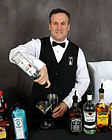Well drink
A well drink or rail drink is an alcoholic beverage served using the lower-cost liquors stored within easy reach of the bartender in the counter "speed rail", "speed rack", or "well".[1][2][3][4]
| Look up well drink in Wiktionary, the free dictionary. |
In any given establishment, the rail/well liquors available may also be known as the "house pours", "house brands", "house spirits", "pour brands", or "proprietary spirits".[1][5][6][4][7]
Well drinks differ from "call" drinks in that the former are offered when a customer does not specify a particular brand of liquor when ordering a mixed drink.[1][2][8]
The actual liquors used by a drinking establishment will vary. A bartender's well may include at least one variety each of gin, rum, whiskey, vodka, bourbon, tequila, triple sec, and vermouth.[1]
Some establishments that cater to higher-end clientele or wish to project an aura of luxury choose premium brands to be their well liquors (thus offering a "premium well").[5][4]
Call and top-shelf
A rail or well drink is usually served when a customer does not specify that a particular brand of liquor be used.[1][2][8] For example, a customer order for a "Scotch and soda" would lead the bartender to use a rail/well Scotch whisky and would be priced as a well drink, whereas ordering "Glenfiddich and soda" would be a call drink.[8]
Call liquors are known as such because the customer "calls" or requests a particular brand of liquor.[9]
Certain expensive brand-name liquors are not considered or priced as call, but are instead known as "top-shelf" liquors, both from their placement on the shelves and from their price relative to the other liquors available.[1]
References
- Lai A, ed. (2005). Bartending 101: The Basics of Mixology. Harvard Student Agencies, Inc. (4th ed.). St. Martin's Press. pp. 7–9. ISBN 978-0-312-34906-6.
In professional bars, a 'speed rail' usually replaces the front bar. This rack, attached to the bar or sink directly in front of the bartender, holds 'house brands' (usually less-expensive brands) of front-bar liquor. The bartender defers to the well brand of liquor for every drink unless the customer specifies a well-known brand, or 'call brand,' as it is known in bartending lingo. The more expensive call brands stay on the back bar. That means that you will prepare a White Russian with generic coffee brandy instead of the most commonly known call brand (Kahlúa) unless the drink specifically requests otherwise (or if your bar is using Kahlúa as its well brand). There is a further classification of alcohols called the 'premium' or 'top-shelf' brands. These are even higher quality bottles of liquor – such as Bombay gin or Old Grand Dad bourbon.
- Kulp K (2014). Booze for Babes: The Smart Woman's Guide to Drinking Spirits Right. Hundred Proof Publishing Co. p. 113. ISBN 978-0-9857731-0-6.
Rail liquors are the selection of bottles bartenders keep in the long shelf under the bar counter, called the rail. These bottles are usually the cheapest liquor they carry, and are often used automatically unless you, or the cocktail menu, specify otherwise.
- Katsigris, Costas; Thomas, Chris (2012). The Bar and Beverage Book (5th ed.). John Wiley & Sons. p. 704. ISBN 9780470248454.
speed rail, speed rack. A bottle-width rack for liquor bottles that is attached to the apron of underbar equipment.
- Feinstein AH, Stefanelli JM (2008). Purchasing: Selection and Procurement for the Hospitality Industry. John Wiley & Sons, Inc. p. 567. ISBN 978-0-470-31485-2.
Well liquor, sometimes called the 'house brand,' is served when a patron asks for a shot of Scotch without specifying a particular brand. The term well derives its name from where this type of liquor is located, typically being stored in a well located just below the bar top. [...]Many foodservice and bar operations serve premium brands as their well brands. This is sometimes referred to as the 'premium well'...
- Katsigris C, Thomas C (2006). The Bar and Beverage Book (4th ed.). John Wiley & Sons, Inc. p. 179. ISBN 978-0-470-07344-5.
In short, the well is an important profit center that should reflect the bar's image and respond to the desires of its clientele.[...] To determine whether or not to upgrade your house pours to premium pours, ask yourself these questions: [...] Are the current house pours a liability? It's a fact that most bar owners stock their well and don't think much about it after that.
- Shock, Patti J.; Stefanelli, John M. (2008). A Meeting Planner's Guide to Catered Events. John Wiley & Sons, Inc. p. 72. ISBN 978-0-470-39095-5.
Well Brand[...] Sometimes it is referred to as a pour brand, proprietary brand, house brand, or speed rail brand.
- Kokt, Desere (2015). Hospitality Management: A practical introduction. African Sun Media. p. 93. ISBN 9781920382698.
- Meyer A, Vann M (2013). How to Open and Operate a Restaurant (electronic ed.). Globe Pequot. p. 100. ISBN 978-1-4930-0144-6.
'Well liquor' is the group of spirits that are used to make drinks when the brand is not specified by the guest ('scotch and soda'). 'Call' liquors are specifically requested brands ('Glenfiddich and soda').
- Brown DR (2004). The Encyclopedia of Restaurant Forms. 1. Atlantic Publishing Company. p. C3-3. ISBN 978-0-910627-29-0.
Call Liquor. Any liquor other than well liquor. The term refers to "calling" the liquor brand by name, such as "Captain Morgan and coke" rather than "rum and coke."
